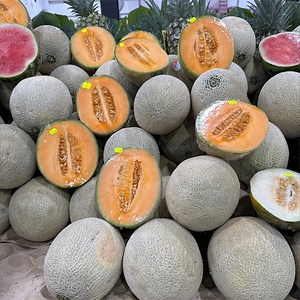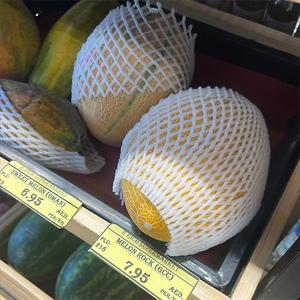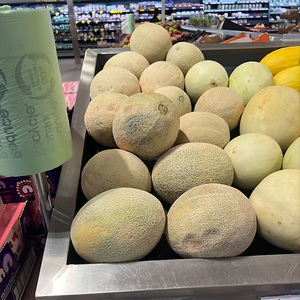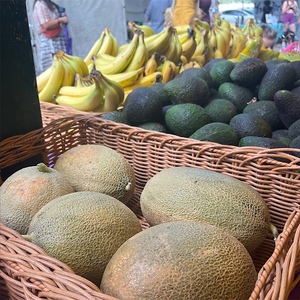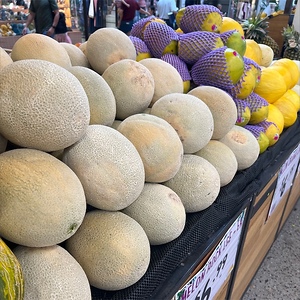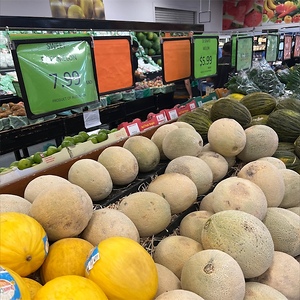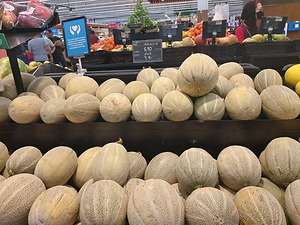


Rock Melons
Estimated Inventory, lb : 0
Description/Taste
Rock melons are a general category of small to medium-sized melons, averaging 15 to 25 centimeters in length and 1 to 11 pounds, and have a round, oblong, to slightly elongated shape with blunt, curved ends. There are several types of melons generally labeled as Rock melons, some with beige-green, rough, firm, and warty to lightly ribbed skin, while other melons bear a pale beige-grey, netted or webbed exterior over a light green to tan, thin rind. Underneath the surface, the flesh is thick, dense, aqueous, and tender with a succulent, slightly sticky consistency. The flesh is mainly orange, but just below the rind, there is a faint green ring. There is also a central cavity filled with stringy fibers and ivory, oval seeds encased in a light coating of gelatinous liquid. Select Rock melons that feel heavy for their size and emit a dull, deep sound when tapped, indicating fruit ripeness. Rock melons have a honeyed, musky, and floral aroma when ripe and will feel heavy for their size, yielding slightly to pressure at the blossom end. The melons are edible raw when ripe and have a distinct, sweet, floral, musky, and fruity flavor.
Seasons/Availability
Rock melons are available year-round in Australia, with a peak season from August to April. Outside Australia, Rock melons are known as cantaloupes and are typically harvested in the summer.
Current Facts
Rock melons, botanically classified as Cucumis melo, are a general category of multiple varieties of melons belonging to the Cucurbitaceae family. The descriptor is a term used in Australia and New Zealand for cantaloupes. Worldwide, there are two main types of cantaloupes: European cantaloupes, also known as true cantaloupes, and North American cantaloupes, or common or conventional cantaloupes. European cantaloupes are classified as Cucumis melo var. cantalupensis and are primarily grown in Europe, Asia, and Australia. The melons have a hard, dense rind that showcases beige-green hues and are often covered in rough, wart-like protrusions. North American cantaloupes, or Cucumis melo var. reticulatus, bear a light tan, netted rind and are a type of muskmelon valued for their thick orange flesh. Both kinds of cantaloupe are sold under the general Rock melon name in Australia. Rock melon is written as Rock melon and Rockmelon in commercial markets and the name was given to the species for its similarity in appearance and shape of a rock. Many different varieties of cantaloupe are sold under the Rock melon category, and the melons are grown throughout Australia for year-round production. Rock melons grow on trailing vines and are harvested by hand once ripe, as the melons will not mature off the vine. Rock melons are then sold domestically or exported as a fresh eating fruit. Rock melons are favored for raw preparations and are sweet and aromatic with dense flesh.
Nutritional Value
Rock melons are a source of fiber to regulate the digestive tract, potassium to balance fluid levels within the bloodstream, vitamin C to strengthen the immune system, and vitamin A to maintain healthy organs. Melons also provide magnesium to control nerve functions, vitamin K to assist in wound healing, vitamin E to protect the cells against the damage caused by free radicals, and other nutrients, including thiamine, vitamin B6, folate, and niacin. Rock melons have high water content and are viewed as a source of natural hydration.
Applications
Rock melons have a sweet, musky, fruity, and floral taste suited for fresh preparations. The melon’s rind should be scrubbed and washed with soap and water to remove harmful bacteria, and once cleaned, the melon can be sliced into wedges, cubes, and pieces. The seeds are also removed from the center cavity and can be cleaned, roasted, and dried as a crunchy snack. Rock melons are popularly sliced in half, the seeds removed, and the flesh is eaten with a spoon. Once slightly hollowed, Rock melon halves can be used as a bowl and filled with savory salads, fruit medleys, or meat dishes. Ice cream is also placed onto the melon half and eaten as a refreshing dessert. Try slicing Rock melons into thin slivers and wrapping them in prosciutto or other cured meats. Pieces of the flesh can also be layered into parfaits and served as an edible topping over oatmeal, cereal, pancakes, and other breakfast dishes. Rock melons can be pureed for chilled soups, blended into smoothies and shakes, used as a flavor for cocktails, or incorporated into sorbet. The melons are not traditionally cooked, but some chefs simmer the melons with sugar to create a marmalade or lightly grill the surface for a rich, deep flavor. Rock melons pair well with seafood such as scallops, calamari, crab, and prawns, herbs such as mint, basil, and cilantro, other fruits including kiwi, strawberries, citrus, and watermelon, cheeses such as goat, feta, and ricotta, and nuts such as hazelnuts, almonds, and pistachios. Whole, unwashed Rock melons can be left at room temperature to soften for up to three days. It is important to note that most melons do not ripen after being picked. Their flesh becomes softer in consistency, but the sugar levels stay the same. Once softened, the melons should be consumed immediately for the best quality and flavor. Rock melon slices can be stored in the refrigerator in a sealed container for three days.
Ethnic/Cultural Info
Rock melons are notably cultivated in Chinchilla, a town in the Western Downs Region of Queensland, Australia. Chinchilla is self-proclaimed the “melon capital of Australia” and is known for producing Rock melons, watermelons, and honeydew. Every two years, Chinchilla celebrates their agricultural history of producing melons with the Chinchilla Melon Festival. The event was established in 1994 to lift the morale of the town after severe droughts plagued the region, and it is one of the oldest running festivals in Australia. The first Chinchilla Melon Festival had around 2,500 attendees, and at the present, the festival can attract over 15,000 visitors. During the festival, melons, in general, are celebrated through contests, live entertainment, pie-eating competitions, a melon ironman, a parade, and marketplaces filled with fresh fruits and homemade products. The most heavily promoted fruit of the festival is the watermelon, as it is featured in the famous melon skiing competition. Participants place their feet into two watermelon halves and are towed by a rope across a slippery stretch, competing to see how long they can remain standing. Rock melons are also seen at the festival but are more a part of the region’s heritage than a publicized focus of the event. Despite their lack of marketing, the melon variety is still sold as fresh fruit at the festival and is also incorporated into various chef-inspired dishes.
Geography/History
Rock melons, also known as cantaloupes, are believed to be native to Persia and Western Asia and have been cultivated since ancient times. The melons were spread to North Africa, specifically Egypt, sometime before 2400 BCE and were also introduced to East Asia and Europe. Original cantaloupe varieties were smaller and not quite as sweet as modern cultivars, but over time, the melons were naturally bred to exhibit a uniform size, improved flavor, and disease resistance. Many varieties of cantaloupes were also developed from commercial cultivation throughout Europe, the Middle East, and Asia. Cantaloupes were introduced to Australia in 1787 through the First Fleet, a group of eleven ships that sailed from Portsmouth, England, and landed in Botany Bay, later moving to a nearby harbor now known as Sydney. After their introduction, cantaloupes were named Rock melons, and new varieties were selectively bred across the continent. Today, Rock melons are commercially grown in New South Wales, Queensland, the Northern Territory, and Western Australia. When in season, Rock melons are sold domestically throughout Australia and are also exported to New Zealand, Singapore, and Japan.







